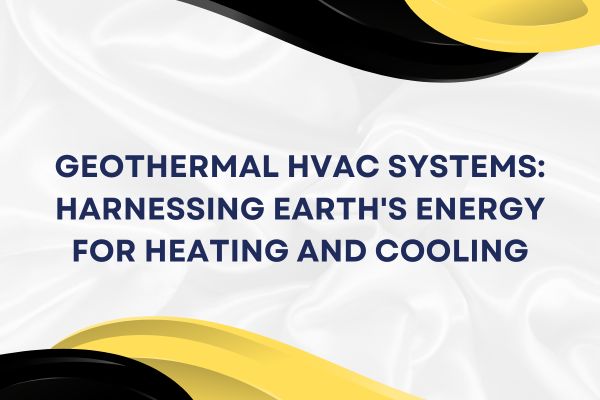Geothermal HVAC systems harness Earth’s natural thermal energy, providing sustainable and efficient heating and cooling year-round, gaining popularity for cost-efficiency and eco-friendliness. Here, we examine the concepts, elements, advantages, and crucial factors of geothermal HVAC systems.
Principles of Geothermal HVAC
At the core of geothermal HVAC systems lies the principle that the Earth’s subsurface maintains a relatively constant temperature, typically between 45°F (7°C) and 75°F (24°C), depending on location. Geothermal heat pumps harness this stable thermal reservoir to provide space heating, space cooling, and hot water. They operate by transferring heat to or from the ground through a loop system.
How Geothermal HVAC Systems Work
Geothermal HVAC systems utilize the Earth’s stable underground temperature for efficient building heating and cooling. They employ a network of pipes, either vertically in boreholes or horizontally in trenches, containing a heat transfer fluid, usually water mixed with antifreeze, to circulate through the system. During the winter, when outdoor temperatures drop below the stable underground temperature, the geothermal system extracts heat from the ground loop. The heat pump within the HVAC system compresses this heat, raising its temperature, and circulates it throughout the building using ductwork or radiant floor heating. Conversely, in the summer, when outdoor temperatures rise, the system absorbs excess heat from the building and transfers it to the ground loop, cooling the air for air conditioning. This straightforward process ensures year-round comfort efficiently.
Benefits of Geothermal HVAC Systems:
- Energy Efficiency: Geothermal systems are highly efficient because they move heat instead of generating it. This reduces energy use and utility costs significantly.
- Environmental Sustainability: Geothermal systems slash greenhouse gas emissions by tapping Earth’s natural heat, reducing reliance on fossil fuels for HVAC.
- Consistent Comfort: Geothermal systems provide consistent heating and cooling, regardless of external weather conditions. It ensures year-round comfort for building occupants.
Durability and Low Maintenance:
Geothermal systems are known for their longevity. Underground components last for decades, and the above-ground heat pump typically lasts 20-25 years. Additionally, they require minimal maintenance.
- Space Efficiency: Geothermal systems require less space due to underground ground loop installation, making them versatile for residential and commercial use.
- Financial Incentives: Government incentives and tax credits promote geothermal HVAC adoption. These incentives may partially offset the upfront installation costs.
Considerations for Geothermal HVAC Installation:
While geothermal HVAC systems offer numerous benefits, there are some considerations to keep in mind:
- Upfront Costs: Geothermal systems often have higher upfront costs than traditional HVAC. However, lower long-term operating expenses and available incentives often offset this cost.
- Installation Space: Geothermal systems require sufficient land or space for ground loop installation. Vertical boreholes require less surface area but are more expensive to install than horizontal loops.
- Proper Sizing: Properly sizing the system based on a building’s heating and cooling load is essential for optimal performance and energy efficiency. It requires a detailed assessment by a qualified HVAC professional.
- Maintenance: While geothermal systems have lower maintenance needs than traditional HVAC systems, regular checks and maintenance by a qualified technician are essential to ensure continued efficiency and performance.
- Water Availability: Open-loop geothermal systems require a reliable source of water for heat exchange. Locations with limited water resources often prefer closed-loop Systems.
Compatibility with Existing Infrastructure:
Retrofitting an existing building with a geothermal HVAC system may require modifications to the Existing heating and cooling infrastructure. Climate Grip plays a pivotal role in optimizing geothermal HVAC systems, aligning perfectly with their sustainable and innovative principles. By integrating advanced sensors and monitoring systems into geothermal setups, Climate Grip ensures real-time tracking of temperature differentials and system performance. This continuous monitoring allows for precise adjustments, enhancing energy efficiency and maintaining consistent indoor comfort. Moreover, Climate Grip’s intelligent control systems can dynamically adapt the heat exchange process based on real-time data, optimizing the geothermal system’s performance for both heating and cooling. As these systems are known for their environmental sustainability and energy efficiency, Climate Grip’s technology further reduces operational costs and minimizes greenhouse gas emissions. Their commitment to sustainability complements the core principles of geothermal HVAC systems, making them an invaluable partner in the journey towards eco-friendly indoor climate control.
Conclusion:
Geothermal HVAC systems use Earth’s stable subsurface temperatures for eco-friendly, cost-effective heating and cooling, offering consistent comfort and sustainability. Geothermal systems offer exceptional efficiency, eco-friendliness, and low maintenance. Despite initial costs and space needs, long-term benefits and incentives make them a compelling choice for homes and businesses. Climate Grip’s role in optimizing geothermal HVAC systems through real-time monitoring, dynamic control, and sustainability alignment reinforces the path toward eco-friendly indoor climate control. This partnership between innovative technology and sustainable principles promises a brighter, greener future for indoor climate regulation.

